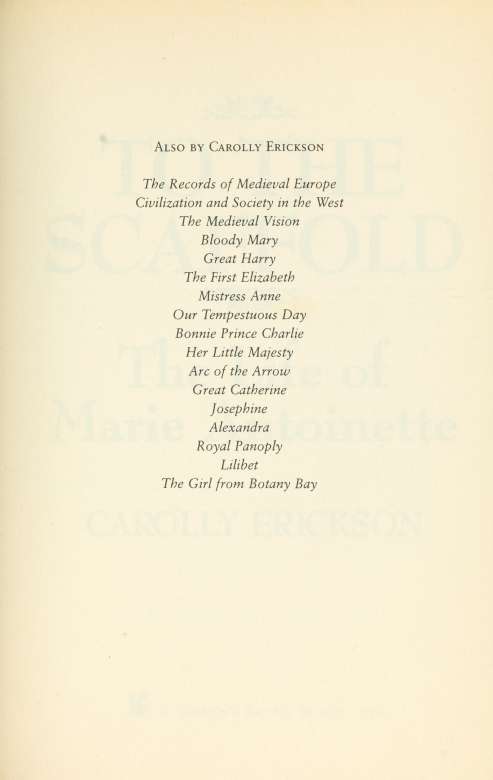Erickson - To the Scaffold, The Life of Marie Antoinette
Here you can read online Erickson - To the Scaffold, The Life of Marie Antoinette full text of the book (entire story) in english for free. Download pdf and epub, get meaning, cover and reviews about this ebook. year: 1991, publisher: Macmillan, genre: Non-fiction. Description of the work, (preface) as well as reviews are available. Best literature library LitArk.com created for fans of good reading and offers a wide selection of genres:
Romance novel
Science fiction
Adventure
Detective
Science
History
Home and family
Prose
Art
Politics
Computer
Non-fiction
Religion
Business
Children
Humor
Choose a favorite category and find really read worthwhile books. Enjoy immersion in the world of imagination, feel the emotions of the characters or learn something new for yourself, make an fascinating discovery.
- Book:To the Scaffold, The Life of Marie Antoinette
- Author:
- Publisher:Macmillan
- Genre:
- Year:1991
- Rating:3 / 5
- Favourites:Add to favourites
- Your mark:
To the Scaffold, The Life of Marie Antoinette: summary, description and annotation
We offer to read an annotation, description, summary or preface (depends on what the author of the book "To the Scaffold, The Life of Marie Antoinette" wrote himself). If you haven't found the necessary information about the book — write in the comments, we will try to find it.
One of historys most misunderstood figures, Marie Antoinette represents the extravagance and the decadence of pre-Revolution France. Yet there was an innocence about Antoinette, thrust as a child into the chillingly formal French court.
Married to the maladroit, ill-mannered Dauphin, Antoinette found pleasure in costly entertainments and garments. She spent lavishly while her overtaxed and increasingly hostile subjects blamed her for Frances plight. In time Antoinette matured into a courageous Queen, and when their enemies finally closed in, Antoinette followed her inept husband to the guillotine in one last act of bravery.
In To the Scaffold, Carolly Erickson provides an estimation of a lost Queen that is psychologically acute, richly detailed, and deeply moving.
This smoothly written biography concentrates on social history, although Erickson ( Bonnie Prince Charlie ) also details the political and economic background of 18th-century France. Marie Antoinette (1755-1793) was raised the daughter of Empress Maria Theresa in the Viennese court of the Hapsburgs, at whose lavish balls and fetes as many as 10,000 guests might dine. But Versailles, where she reigned after marrying King Louis XVI of France, glittered even more, and Erickson recreates its life aptly, describing the elaborate clothes, the duties of courtiers, the rigid etiquette. While the queens education had equipped her for the role of royal hostess, she was ill-prepared to deal with the intrigues surrounding her. At first timid, fearful and passive, Antoinettesic gradually grew brittle and hardened by a constant surfeit of pleasures. The author believes the queen had only one extramarital love, a Swedish nobleman named Axel Fersen. And she argues that Antoinette, condemned to death by revolutionaries, finally showed courage and dignity: her last words were an apology to her executioner for accidentally stepping on his foot. Although the book does not add a great deal of new information, it is a highly readable account.
Copyright 1991 Reed Business Information, Inc.
YA-- Much maligned in her lifetime, Marie Antoinette is likewise much misunderstood by history, which portrays her as a vain, selfish, and insensitive woman of limited intellect. Erickson attempts to right the wrongs and correct the image of this queen in an easily read biography that avoids both academic cant and psychohistorical pretension. Tracing Marie Antoinette from her childhood among her 13 brothers and sisters at the court of her legendary mother, Empress Maria Theresa of Austria, the author portrays her not as the selfish queen of lore but as a reasonably intelligent, opinionated woman of decidedly conservative bent whose ultimate crime, for which she paid with her life, was having the wrong title in the wrong place at the wrong time. To the Scaffold will be enjoyed by students of European and French history. --Roberta Lisker, W. T. Woodson High School, Fairfax, VA
Copyright 1991 Reed Business Information, Inc.
Erickson: author's other books
Who wrote To the Scaffold, The Life of Marie Antoinette? Find out the surname, the name of the author of the book and a list of all author's works by series.






















